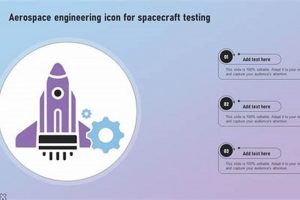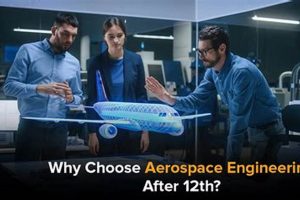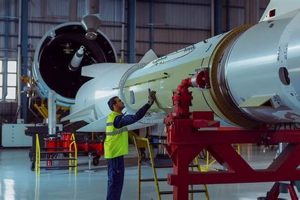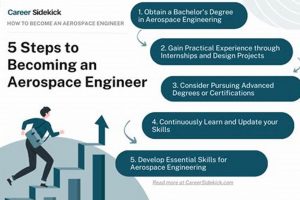Aerospace engineering is a field concerned with the design, development, testing, and production of aircraft and spacecraft. Professionals in this discipline might work on projects ranging from commercial airliners and military jets to satellites and space exploration vehicles. Their duties encompass conceptualizing new technologies, analyzing aerodynamic performance, creating structural designs, and ensuring the safety and reliability of aerospace systems. For example, an engineer might design a more fuel-efficient wing for an aircraft or develop a heat shield for a spacecraft re-entering the Earth’s atmosphere.
The field holds significant importance due to its role in advancing transportation, communication, and scientific exploration. Efficient and reliable aircraft are vital for global trade and travel. Satellites enable communication, navigation, and weather forecasting. Spacecraft allow for the exploration of our solar system and the universe beyond. Historically, aerospace engineering has driven technological innovation, leading to breakthroughs in materials science, propulsion systems, and control systems, benefiting other industries as well.
Therefore, this exploration will delve into the specific tasks and responsibilities associated with this area of engineering, highlighting the diverse skill sets required and the significant impact these professionals have on society and technology.
Guidance for Aspiring Professionals in Aerospace Engineering
The following offers insights for individuals considering a career in aerospace engineering, emphasizing key areas for skill development and career advancement.
Tip 1: Solidify Foundational Knowledge: A strong understanding of mathematics, physics, and computer science is essential. These disciplines provide the bedrock for analyzing complex aerospace systems and developing innovative solutions. Consistently review and apply these principles.
Tip 2: Develop Proficiency in CAD and Simulation Software: Mastering industry-standard tools such as CATIA, SolidWorks, and ANSYS is crucial for design, analysis, and simulation. Practice using these tools to model components, simulate flight conditions, and optimize performance.
Tip 3: Seek Hands-on Experience: Internships, research projects, and student competitions offer invaluable practical experience. These opportunities allow application of theoretical knowledge to real-world problems, fostering problem-solving skills and teamwork.
Tip 4: Specialize in a Specific Area: Aerospace engineering encompasses diverse specializations, including aerodynamics, propulsion, structures, and control systems. Focus on a particular area of interest to develop expertise and become a sought-after professional.
Tip 5: Cultivate Communication Skills: Effective communication is vital for collaborating with colleagues, presenting technical findings, and writing reports. Practice clearly and concisely conveying complex technical information through written and verbal channels.
Tip 6: Stay Abreast of Technological Advancements: The field of aerospace engineering is constantly evolving. Regularly read technical journals, attend conferences, and participate in professional development activities to remain informed about the latest advancements.
Tip 7: Build a Professional Network: Networking with other engineers, researchers, and industry professionals can open doors to new opportunities and provide valuable insights. Attend industry events, join professional organizations, and connect with individuals on platforms like LinkedIn.
Adhering to these guidelines can significantly enhance prospects for success in the demanding yet rewarding field of aerospace engineering.
Therefore, diligent application of these strategies will contribute to a fulfilling and impactful career in this vital field.
1. Design aircraft and spacecraft
The design of aircraft and spacecraft constitutes a core function within the broader field of aerospace engineering. The activities involved encompass a wide spectrum of tasks, from conceptualizing initial designs to creating detailed engineering drawings and specifications. This design process directly influences the performance, safety, and capabilities of the final product, be it a commercial airliner, a military fighter jet, or a satellite destined for orbit. The iterative nature of the process involves continuous refinement and optimization based on analysis, simulation, and testing. A fundamental principle of aerospace engineering lies in translating theoretical concepts into tangible, functional designs.
Consider, for example, the design of a new generation of fuel-efficient aircraft wings. Aerospace engineers would employ computational fluid dynamics (CFD) to simulate airflow around various wing profiles, optimizing the shape to minimize drag and maximize lift. Material selection also plays a critical role, ensuring the structure can withstand the stresses of flight while minimizing weight. In spacecraft design, engineers must account for the extreme conditions of space, including vacuum, radiation, and temperature variations. This often necessitates the use of specialized materials and design techniques to protect sensitive components. The ongoing pursuit of lighter, stronger, and more efficient designs drives innovation in aerospace engineering.
Ultimately, the design of aircraft and spacecraft is not merely an abstract exercise but a practical endeavor with profound implications. It shapes the future of air travel, space exploration, and national security. Understanding this fundamental aspect of the field is critical for appreciating the challenges and rewards inherent in a career in aerospace engineering. The success of these designs directly impacts the safety and reliability of the systems upon which society relies, highlighting the profound responsibility placed upon aerospace engineers.
2. Analyze aerodynamic performance
Aerodynamic performance analysis stands as a cornerstone of aerospace engineering. It directly informs the design and operational characteristics of aircraft and spacecraft. Accurate assessment of aerodynamic forces and phenomena ensures efficient flight, structural integrity, and overall mission success.
- Computational Fluid Dynamics (CFD) Simulations
CFD simulations allow engineers to model airflow around complex geometries. This involves solving complex equations numerically to predict lift, drag, pressure distribution, and turbulence. For example, simulating airflow around a wing airfoil allows for the optimization of its shape to minimize drag at cruising speeds, directly influencing fuel efficiency. These simulations provide invaluable insights before physical prototyping.
- Wind Tunnel Testing
Wind tunnel testing provides empirical data to validate CFD simulations and analyze aerodynamic behavior in a controlled environment. Scale models of aircraft or spacecraft are subjected to varying airflow conditions, and sensors measure forces and pressures. An example includes testing the stability of a new aircraft tail design under crosswind conditions. The collected data helps refine designs and identify potential aerodynamic issues that may not be apparent in simulations.
- Flight Testing and Data Analysis
Flight testing serves as the ultimate validation of aerodynamic performance. Instrumented aircraft are flown under various conditions, and sensors record data such as airspeed, altitude, angle of attack, and control surface deflections. Analysis of this data allows engineers to assess the aircraft’s handling characteristics, stability, and performance envelope. Identifying deviations from predicted performance requires further investigation and potential design modifications.
- Aerodynamic Optimization Techniques
Aerodynamic optimization techniques are employed to improve aircraft and spacecraft performance. These techniques often involve using algorithms to automatically adjust design parameters based on simulation or experimental results. Examples include optimizing the shape of a wingtip device to reduce induced drag or optimizing the angle of attack of a control surface to improve maneuverability. These iterative optimization processes lead to significant performance gains.
These diverse facets of aerodynamic performance analysis are integral to the workflow of aerospace engineers. From initial design concepts to final flight testing, a rigorous understanding of aerodynamics is essential for creating safe, efficient, and high-performing aircraft and spacecraft. Neglecting this analysis can lead to catastrophic consequences, underscoring its importance in the field.
3. Develop propulsion systems
The development of propulsion systems represents a critical domain within aerospace engineering, directly dictating the operational capabilities and overall feasibility of flight vehicles. This encompasses a broad spectrum of activities ranging from theoretical design and computational modeling to experimental testing and system integration.
- Rocket Engine Design and Analysis
Rocket engine design focuses on creating systems capable of generating high thrust-to-weight ratios for space launch and orbital maneuvers. This requires detailed thermodynamic analysis, combustion modeling, and structural design to withstand extreme temperatures and pressures. For instance, the development of a new liquid-fueled rocket engine might involve optimizing the injector design for efficient propellant mixing and combustion, thereby maximizing thrust output and minimizing propellant consumption. The efficient operation of these engines is paramount for successful space missions.
- Gas Turbine Engine Design and Optimization
Gas turbine engines, commonly used in aircraft, demand a sophisticated understanding of aerodynamics, thermodynamics, and materials science. Developing these systems involves designing compressors, combustors, and turbines to maximize efficiency and power output while adhering to strict weight and size constraints. An example would be the optimization of a turbine blade profile to improve aerodynamic efficiency and reduce fuel burn in a commercial aircraft engine. Such improvements lead to significant cost savings and reduced environmental impact.
- Propellant and Fuel Research
The performance of propulsion systems is intrinsically linked to the characteristics of the propellants or fuels utilized. Research in this area focuses on developing new chemical formulations or improving existing ones to enhance energy density, combustion efficiency, and storage stability. For instance, research into alternative jet fuels derived from renewable sources aims to reduce reliance on fossil fuels and mitigate environmental concerns associated with aviation. This is essential for sustainable aerospace operations.
- Testing and Validation
Rigorous testing and validation are crucial to ensure the reliability and performance of propulsion systems. This involves subjecting engines and components to simulated flight conditions, measuring performance parameters such as thrust, fuel consumption, and emissions. For example, conducting altitude chamber tests on a rocket engine allows engineers to assess its performance under simulated vacuum conditions. Data obtained from these tests is used to validate design models and identify potential weaknesses before operational deployment.
These facets of propulsion system development are fundamental to the practice of aerospace engineering. Advances in these areas directly translate to enhanced capabilities in air travel, space exploration, and national defense. Therefore, continuous innovation and refinement in propulsion technology remain central to the progress of the field.
4. Ensure structural integrity
Ensuring structural integrity constitutes a paramount responsibility within aerospace engineering. It directly relates to the safety, reliability, and longevity of aircraft and spacecraft. Activities in this area encompass design, analysis, testing, and monitoring to guarantee the structural soundness of aerospace vehicles under diverse operational conditions.
- Stress and Strain Analysis
Stress and strain analysis involves determining the distribution of internal forces and deformations within aerospace structures subjected to various loads. Techniques such as finite element analysis (FEA) are employed to model complex geometries and simulate their response to external forces, thermal stresses, and vibrations. For instance, FEA can be used to analyze the stress concentration around a fastener hole in an aircraft wing under flight loads. The results of these analyses inform design decisions and material selection, ensuring that structural components can withstand the anticipated stresses without failure. This analytical approach is crucial for preventing catastrophic structural failures.
- Material Selection and Testing
Material selection is a critical aspect of ensuring structural integrity. Aerospace engineers must choose materials that possess the required strength, stiffness, and resistance to environmental degradation, while also minimizing weight. Testing of materials under various conditions, such as tensile testing, fatigue testing, and corrosion testing, provides data to validate their suitability for specific applications. For example, selecting a carbon fiber composite for an aircraft fuselage involves evaluating its strength-to-weight ratio, resistance to impact damage, and long-term durability. Proper material selection directly contributes to the structural integrity and operational life of the aerospace vehicle.
- Non-Destructive Inspection (NDI)
Non-destructive inspection (NDI) techniques are used to detect flaws and defects in aerospace structures without causing damage. Methods such as ultrasonic testing, radiography, and eddy current testing can identify cracks, corrosion, and other anomalies that could compromise structural integrity. For instance, ultrasonic testing can be used to inspect the bond between composite layers in an aircraft wing, ensuring that the adhesive bond is free from voids or delaminations. Regular NDI inspections are essential for detecting and addressing potential structural issues before they lead to failure.
- Structural Health Monitoring (SHM)
Structural health monitoring (SHM) systems involve the integration of sensors and data analysis techniques to continuously monitor the condition of aerospace structures. SHM systems can detect changes in strain, vibration, or temperature that may indicate the onset of damage or degradation. For example, fiber optic sensors embedded in an aircraft wing can detect the growth of cracks under fatigue loading. SHM systems provide real-time information about structural health, enabling proactive maintenance and preventing unexpected failures. These systems are becoming increasingly important for ensuring the long-term safety and reliability of aerospace vehicles.
These facets collectively demonstrate the multifaceted nature of ensuring structural integrity in aerospace engineering. They underscore the necessity for a rigorous and comprehensive approach to design, analysis, testing, and monitoring. The application of these techniques is crucial for mitigating risk and maintaining the safety and performance of aircraft and spacecraft throughout their operational lifespan. The continued advancement of these techniques remains essential for meeting the challenges of future aerospace endeavors.
5. Conduct flight testing
Flight testing constitutes a critical phase in the development and certification of aircraft and spacecraft, representing a direct application of aerospace engineering principles. It serves as the ultimate validation of design assumptions, aerodynamic performance predictions, and control system functionality, ensuring the vehicle meets performance specifications and safety standards.
- Instrumentation and Data Acquisition
Flight testing involves equipping the aircraft or spacecraft with a suite of sensors and data acquisition systems to measure key parameters such as airspeed, altitude, acceleration, control surface positions, and structural loads. These sensors provide a continuous stream of data that is recorded and analyzed to assess the vehicle’s performance and behavior. For instance, strain gauges mounted on the wing structure can measure the stress experienced during maneuvers, verifying that the structure is within its design limits. This data is critical for identifying any deviations from expected performance and for validating design models.
- Test Maneuvers and Flight Profiles
Flight testing programs are carefully planned and executed, involving a series of specific maneuvers and flight profiles designed to evaluate different aspects of the vehicle’s performance. These maneuvers may include steady-state flights, climb tests, stall tests, and dynamic maneuvers such as rolls and loops. Each maneuver is designed to assess a particular aspect of the vehicle’s handling qualities, stability, and performance envelope. For example, stall tests determine the aircraft’s behavior at high angles of attack, ensuring that it exhibits predictable and recoverable stall characteristics. The precise execution and documentation of these tests are essential for regulatory certification.
- Data Analysis and Model Validation
The data collected during flight testing is subjected to rigorous analysis to assess the vehicle’s performance and compare it with pre-flight predictions. This analysis involves statistical processing, signal filtering, and the development of performance models. Discrepancies between the measured data and the predicted performance necessitate further investigation and potential design modifications. For example, if the measured drag is higher than predicted, engineers may need to refine the aircraft’s aerodynamic design or improve the surface finish to reduce friction. The validation of design models against flight test data is a crucial step in ensuring the accuracy and reliability of future designs.
- Safety and Risk Management
Flight testing inherently involves a degree of risk due to the experimental nature of the activity and the potential for unexpected events. A comprehensive safety management system is essential to identify and mitigate these risks. This includes thorough pre-flight inspections, detailed flight planning, the use of experienced test pilots and flight test engineers, and the implementation of emergency procedures. For example, a chase aircraft may accompany the test aircraft to provide visual observation and assistance in case of an emergency. The rigorous application of safety principles is paramount to protecting the lives of the flight test crew and ensuring the success of the flight testing program.
The execution of flight testing, therefore, represents a synthesis of theoretical knowledge and practical application within aerospace engineering. It is an iterative process that informs design refinements and validates performance claims, ultimately contributing to the development of safe, efficient, and capable aircraft and spacecraft. The insights gained during flight testing are invaluable for advancing the state-of-the-art in aerospace technology.
Frequently Asked Questions
The following addresses common inquiries regarding the multifaceted nature of aerospace engineering, aiming to clarify its scope and shed light on typical activities undertaken within this field.
Question 1: What are the primary disciplines encompassed within aerospace engineering?
Aerospace engineering integrates elements of aerodynamics, propulsion, structures, control systems, and materials science. These disciplines are applied to the design, development, and testing of aircraft and spacecraft.
Question 2: Does aerospace engineering exclusively involve the design of aircraft and spacecraft?
While design is a core function, aerospace engineering also encompasses research, development, testing, and production. Furthermore, it includes analysis, simulation, and project management roles.
Question 3: What software tools are commonly utilized in aerospace engineering?
Industry-standard software includes Computer-Aided Design (CAD) programs such as CATIA and SolidWorks, Computational Fluid Dynamics (CFD) tools like ANSYS Fluent, and structural analysis software such as NASTRAN. Proficiency in these tools is often a prerequisite for employment.
Question 4: What is the role of mathematics in aerospace engineering?
A strong foundation in mathematics, including calculus, differential equations, and linear algebra, is crucial. These mathematical principles underpin the analysis of aerodynamic forces, structural stresses, and control system dynamics.
Question 5: Are there opportunities for specialization within aerospace engineering?
Yes, aerospace engineers can specialize in areas such as aerodynamics, propulsion, structures, control systems, or space systems. Focusing on a specific area allows for the development of in-depth expertise.
Question 6: What are the key skills required for success in aerospace engineering?
Critical thinking, problem-solving, strong analytical skills, and effective communication are essential. The ability to work collaboratively in multidisciplinary teams is also highly valued.
These FAQs highlight the diverse skills and knowledge required for success in aerospace engineering. A thorough understanding of these aspects is crucial for aspiring professionals in this field.
Further exploration will delve into the career paths and opportunities available within aerospace engineering, providing insights into potential roles and career progression.
Conclusion
This exploration of the activities performed within aerospace engineering reveals a field characterized by complexity, innovation, and critical responsibility. From the initial design phases to the rigorous testing and validation processes, the work demands a diverse skill set encompassing analytical proficiency, problem-solving capabilities, and a commitment to safety. Activities such as aerodynamic analysis, propulsion system development, structural integrity assurance, and flight testing are integral to the creation and operation of aircraft and spacecraft.
The advancements achieved through aerospace engineering have had a profound impact on society, shaping global transportation, communication, and exploration. Continued innovation in this field is essential for addressing future challenges and unlocking new possibilities in air and space. Therefore, those entering this profession assume a vital role in shaping the future of technology and human endeavors beyond Earth.







